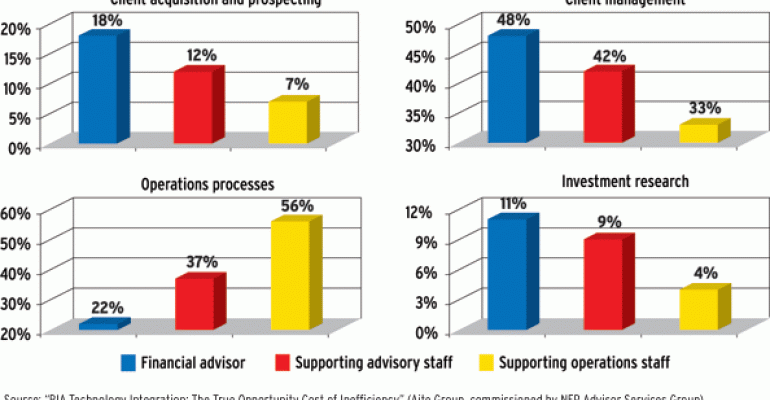The cost of inefficient technology integration at registered investment advisor practices may be more than you would think. A white paper commissioned by NFP Advisor Services Group and prepared by Aite Group says that a primary advisor at an RIA spends 20 percent more time on operations-related tasks (performance reporting, fee billing, and data reconciliation, for example) than on client prospecting and acquisition. But firms that move to fully integrated tech systems can boost their efficiency by an additional half-day per staffer per week, time that can be devoted to more business development, the report says.
Building a business of one’s own is one of the appeals of starting an RIA. But in the course of growing their practices over the years, advisors often assemble a range of hardware and software systems on an a la carte basis that work fine on their own but don’t always cooperate readily with one another. The client relationship management program doesn’t dovetail nicely with the portfolio accounting system, for example.
Aite Group analyst Alois Pirker calls it the “classic growth pains” of a budding RIA. “You add on and once you have a couple of years in, you have a system that works, but it’s very inefficient,” he says. It’s a problem that smaller advisors learn to live with, but once they get to $100 million to $150 million in AUM it becomes more unwieldy; the systems aren’t scalable with more clients, and the practice staff spends more time inputting data from one system to another. Some advisors are reluctant to change their systems because of the investments they’ve made in them. “The sunk costs are not only monetary but emotional as well,” Pirker says. “It’s a blood, sweat and tears kind of thing. They try to fit these things together and make sure it works. It’s something they’ve learned to love…For them, changing is having to jump over your own shadow.”
RIAs estimate that the average level of integration among their various business applications is less than 50 percent. That’s not surprising, given that 41 percent of RIAs hold less than $100 million in AUM, according to the Investment Adviser Association. But there’s a price that’s paid in practice efficiency, the Aite report says. Financial advisors in their survey say they spend more time on operations processes—22 percent—than they do on the bread-and-butter activities of client acquisition and prospecting—18 percent. Among junior advisory staff, the numbers are worse; 37 percent of their time is spent on operations, compared to 12 percent on business development.
For practices that adopt fully integrated technology systems, the quality-time savings can be substantial, the Aite report says. The amount of time devoted to client acquisition roughly doubles, boosted by the decline in time spent on operational issues. The report estimates that an RIA with a staff of four would reduce time spent on operational issues by 21 weeks annually. RIAs with larger staff and assets of $100 million to $500 million would reduce time spent on operations issues by 114 days as a result of fully integrated technology.
James Poer, president of the NFP Advisor Services Group, said full integration is a solution that’s typically embraced by breakaway brokers who didn’t have to assemble tech systems in their former lives and aren’t looking to learn how to do it now. Integration also is attractive to practices seeking efficiencies that will allow them to grow, he added. Smaller practices can maintain their tech systems for a while, but he warned that eventually technological changes will force them to upgrade across their platform (just as buying a new state-of-the-art computer means software upgrades, since the new machine won’t run the old programs.) Advisors who pursue piecemeal tech solutions are, in his words, “building the business of the ‘90s.”







